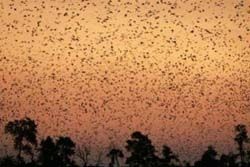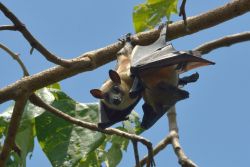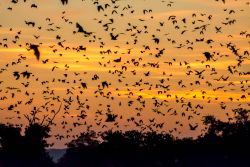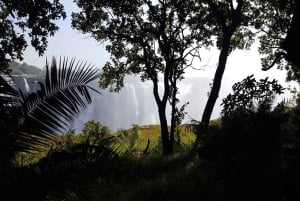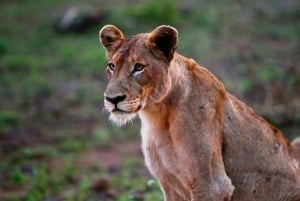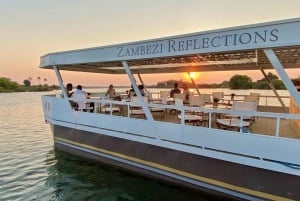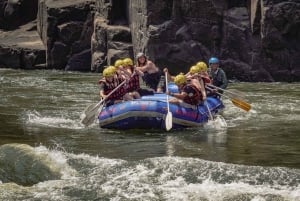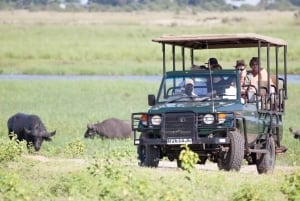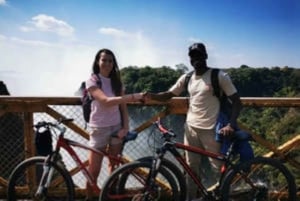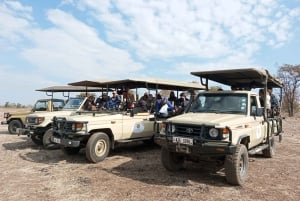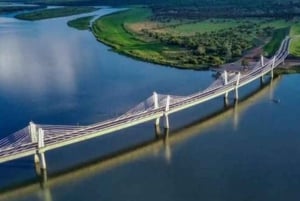Kasanka National Park
Kasanka National Park is rapidly gaining worldwide fame for the annual “Bat Migration”, the second largest mammal concentration in the world and considered one of the world’s great wildlife spectacles, as well for the huge diversity in flora and fauna including Zambia’s tallest tree. It is often overlooked by visitors planning a trip to Zambia, but never ceases to impress when they arrive and leave with fond memories.
Kasanka National Park lies within the Chitambo Chiefdom in the northern part of Central Province and forms part of the Greater Bangweulu Ecosystem. It was designed around the rich swamps and floodplains of the Kasanka and Musola Rivers. Kasanka was initially designated a Game Reserve in 1946 and gazetted as a National Park in 1972. Since 1990, the National Park has been managed under a Public Private Partnership (PPP) co-management construction between the now Zambia Wildlife Authority and Kasanka Trust Ltd . With that it has the longest PPP history of any National Park in Zambia.
The National Park is approximately 390 km2 making it the 5th smallest of the 20 National Park’s in Zambia. It is easily accessed off the Mpika (T2) road on the D235 towards Mansa, approximately 5-7 hours’ drive from the Copperbelt and Lusaka respectively. there is also a well maintained gravel airstrip (Mulembo) available for small plane charter flights.
The National Park lies within the high rainfall area of northern Zambia. As with the whole of Zambia, the dictating climatic features are a long hot wet season (November-April) followed by a cold dry season (May-July) and a hot dry season (August-October). Annual rainfall averages 1093mm. Although Zambia lies within the tropical zone, temperatures are relatively mild due to the ameliorating effect of altitude. Average daytime temperatures range between 14° and 33° Celsius, with recorded minimum and maximum extremes of 4° and 40° Celsius, respectively. Frost at ground level is known to occur regularly in the winter months.
Kasanka National Park is named after the Kasanka River that flows through the centre of the park. The Bemba word “kasanka” means “harvesting place” or “place where animals gather”, reflecting the historical richness of the ecosystem along this river.
The National Park is characterized by numerous rivers flowing in from the south and east, which are all tributaries of the Luwombwa River. The Luwombwa is the only river draining the park, and it in turn joins the Luapula River downstream of Kasanka National Park.
Stretches of seasonally and permanently wet habitats are found along all these rivers, while areas away from the rivers are predominantly covered by miombo woodland. There is little variation in altitude across the National Park, with altitudes rising from around 1160 m AMSL reaching a maximum elevation of1286 m AMSL on Mpululwe Hill in the south-eastern part of the park.
Kasanka National Park holds a unique small-scale diversity of intact habitats, often of great scenic beauty, including threatened habitats such as the mushitu and mateshe evergreen forests and extensive peat swamps and plains. The National Park is dominated by miombo woodlands but also protects a wide range of other vegetation types, notably large surfaces of (seasonally) wet habitats and evergreen forests. The impressive biodiversity recorded in the park is reflected in the species lists which include 114 mammals, 476 birds, 60 reptiles, 41 amphibians and 66 fish.
The main patch of Mushitu Swamp Evergreen Forest, some 40 hectares, is found on the Musola River near Fibwe, forms one of the larger mushitu forests in Zambia. Also known as the “Bat Forest”, it harbours the massive seasonal colony of Straw-coloured Fruit Bats (Eidolon helvum) and hence of great ecological significance.
With some 10 million individuals estimated to be present during the peak period, a significant part of the subequatorial population of this Near-Threatened species is present in the National Park in October to December each year and can be viewed from various strategically placed exclusive viewing platforms, including the 21m high BBC platform and public viewing areas. They form the second largest known concentration of mammals in the world and the “Bat Migration” is considered one of the world’s great wildlife spectacles – never forgotten by those lucky enough to witness it.
The “Bufumu Tree”, a 65 metre tall Mofu or Mofwe Tree (Entandrophragma delevoyi) is located adjacent to the Mateshe dry evergreen Bufumu Forest (Thicket), which is the tallest known indigenous tree in Zambia. The presence of royal graves at its base has meant the tree has enjoyed protection from being harvested to make dugout canoes, and several very tall individuals are found within what presumably were the limits of the protected “Sacred Forest”.
Kasanka National Park is recognized as an Important Bird Area (IBA). To date 476 bird species have been recorded, which makes it the longest list of any National Park or IBA in Zambia only after the much larger Kafue National Park. New species are still regularly added. It reflects the high small-scale diversity in habitats of the park. The national park is increasingly well known as a bird watching destination.
Many of the “specials” are typical for evergreen forests (e.g. Purple-throated Cuckooshrike, Böhm’s Bee-eater, Ross’s Turaco, Black-backed Barbet, Bocage’s Akalat, Brown-headed Apalis and Blue-mantled Crested Flycatcher), forested rivers (e.g. Pel’s Fishing-Owl, African Finfoot and Half-collared Kingfisher), dambo grasslands (e.g. Locustfinch, Streaky-breasted Flufftail and Blue Quail) and miombo woodlands (e.g. Anchieta’s Sunbird, Black-necked Eremomela and Böhm’s Flycatcher).
Kasanka National Park might hold the highest density and most visible population in the world of the scarce and highly valued Sitatunga, a shy aquatic antelope with splayed hooves which spends its days in thick papyrus swamps. Fibwe Hide, a viewing platform 18 metres up in a Red Mahogany (Mululu) tree overlooking the Kapabi Swamps is one of the best places in Kasanka to see them. The Puku, near-endemic to Zambia, is the most abundant antelope species in the park and represents one of the largest populations in the world. The only remaining healthy population of elephant in the Zambian Congo system and adjacent parts of the Democratic Republic of Congo (DRC) is found in the National Park.
The Kinda Baboon, restricted to parts of northern Zambia and adjacent DRC and Angola, makes Kasanka National Park one of very few easily accessible sites where tourists have a realistic chance to see the species. The presence of a well-studied and habituated group is of great value and potential for science and tourism.
There are 2 permanent lodges in Kasanka: Wasa and Luwombwa.
-
Wasa Lodge lies on the edge of Lake Wasa in the eastern half of the park just 12 kms from the park entrance at the tarmac road. It is ideally suited for visiting the hide at Fibwe (just 15 minutes’ drive or 2 hours walk away) and has a fine view with Puku, Hippo and sometimes even Sitatunga visible from the lodge. The lodge which is the main reception in the National Park has a main building housing a bar, dining room and veranda overlooking the lake. All the buildings have thatched roofs and are in a traditional style.
-
Luwombwa Lodge is located on the banks of the Luwombwa River in the western half of the park; this lodge has three en-suite chalets overlooking the river. The prime attraction of Luwombwa Lodge is certainly the river; unlike most safari river trips, the Luwombwa is a gentle meandering stream heavily fringed with evergreen forest. Bird watching can be great with African Finfoot, Narina Trogon and Pel’s Fishing Owl all regularly seen, not to mention a variety of kingfishers and bee-eaters amongst other species.
For fishermen a special permit is available allowing you to catch Bream (Tilapia), Barbel Fish and sometimes the much sought after tigerfish. Motorboats and canoes with guides are available at the lodge.
Luwombwa also has nearby game viewing, notably at the Chikufwe Plain where the old airstrip is located, and Reedbuck, Lichtenstein’s hartebeest, Sable antelope and buffalo may be seen.
There are currently 3 camping sites available for visitors in Kasanka; one is at the old “Pontoon” crossing along the Kasanka river, another downstream across the Kasanka at “Kabwe” and a third exclusive campsite at the Bufumu forest. Campers should bring all their own tents and equipment, as the sites only have a simple toilet, shower and shelter. Staff are on hand to help with water.
At Mulaushi, Kasanka Conservation Centre (KCC) close to the gate, we offer simple accommodation in guestrooms with shared facilities.
Guided walks with an armed escort and / or guide can be arranged at the Wasa lodge reception. Self-drive guests and day visitors are welcome to go on their own game drives through the park. Guided game drives can be arranged for those wishing to enjoy the experience in an open vehicle.
Wasa lodge is 3km from the Mulembo airstrip (Co-ordinates: S12 32 19.0 E30 18 35.8) for guests who opt to fly to the National Park.
Getting there:
Driving times from Lusaka or the Copperbelt are typically 5-6 hours. The roads are all tarred up to the park entrance and in excellent condition.
From Lusaka, take the Great North Road passing through Kabwe on to Kapiri Mposhi. Pass through Kapiri, then turn right after about 4 kms towards Mpika and Tanzania.
From the Copperbelt, turn left 4kms before Kapiri town towards Mpika and Tanzania.
 Then continue 200kms, passing the Mkushi turn-off, and you will reach the Serenje turn-off, with a filling station. It is recommended to fill up here as it is the last fuel stop. Continue on the main road for 36km until you will find a tarred road on your left signed to ‘Mansa’. Turn left here, and continue for 55km, at which point you will see a large sign to Kasanka and the park gate on your left side.
Then continue 200kms, passing the Mkushi turn-off, and you will reach the Serenje turn-off, with a filling station. It is recommended to fill up here as it is the last fuel stop. Continue on the main road for 36km until you will find a tarred road on your left signed to ‘Mansa’. Turn left here, and continue for 55km, at which point you will see a large sign to Kasanka and the park gate on your left side.


